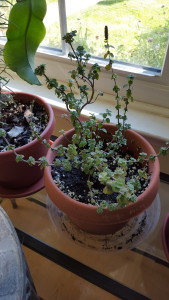I am often asked if herbs can be grown indoors. My answer is “Yes, but . . . “. It is not enough to set your herb plants in a sunny window. What looks like bright light to us can be less than 10% of outdoor sunlight. To successfully grow herbs indoors the most important things that you need are a south- or southwest facing window and supplemental lighting.
Light
Most herbs are sun lovers. Outdoors, they need a minimum of 6 to 8 hours of direct sunlight. Indoors, they need a south- or southwest facing window that gets a minimum of 4 to 6 hours of sunlight per day. You will need to supplement that with artificial lighting. There is no need to buy expensive Gro lights. Plain old 40 watt cool fluorescent lights are fine. The number of hours the lights need to be on depends on how many hours of light the window gets. The ratio to use is 2 hours of fluorescent lighting equals 1 hour of sunlight. So if your window only gets 4 hours of sunlight each day, you will need to have the fluorescent lights on for an additional 4 to 8 hours to equal the additional 2 to 4 additional hours of sunlight required by your herbs.
There are a few herbs that can tolerate light shade outdoors. Partial shade is defined as 3 to 6 hours of direct sunlight per day. You can grow them in a window that gets fewer hours of sunlight per day and make up the difference with fluorescent lights. Just remember that most shade tolerant herbs are just that. They “tolerate” shade. They don’t grow as well, get as big or flower in the shade.
Temperature
Herbs should not be grown near heat sources such as air ducts or radiators. They prefer cooler temperatures. Daytime temperatures of 65⁰F to 70⁰F with nighttime temperatures of 55⁰F to 60⁰F is ideal. It’s important that your herbs are not near drafts from air conditioners or outside doors in the winter. Blasts of cold air will chill them and weaken the plants leaving them open to disease.
Containers & Soil
Make sure you use pots that are an appropriate size for the full-grown plant. If you are growing from seed or purchase seedlings, you will need to transplant your herbs into successively larger pots as they grow larger. If not, the plants will become stunted and may die. Clay pots are often recommended but I prefer plastic pots because they are much lighter and easier to handle.
Herbs require good drainage. Use only pots that have drainage holes so that water doesn’t pool in the pots and drown your plants. Always use sterile potting soil and mix it with equal parts peat moss and perlite so that water runs easily through it.
Watering
Water your herbs only when the soil becomes dry. Add water until it begins to come out of the drainage hole, then stop until the soil dries out again. Do not over-water.
The air in our homes is very dry. Adding a little humidity to your herbs will help them survive indoors. You can either mist them daily or place the containers in trays of gravel and water the gravel regularly. The evaporating water will provides much needed humidity.
Fertilizer
Although most herbs prefer poor soil outdoors, when grown in containers indoors, they need supplemental fertilizing because as the water runs through the soil and out the drainage hole, it is leaching nutrients. You can use liquid fertilizer or fish emulsion. A light dose of fertilizer every two weeks works best. Too much fertilizer will cause your herbs to grow tall and lanky with less of the oils that give them their flavor and scent.
Pests
Herbs grown indoors are subject to the same pests that affect your houseplants. You can control them with either commercial insecticidal soap or make your own using 1 or 2 tablespoons of mild dish soap in a gallon of water. You can either dip the whole upper part of the plant and gently swish it around in a tub of soap or spray your plants once a week until the pests are gone. Don’t forget to wash the leaves before using them!



